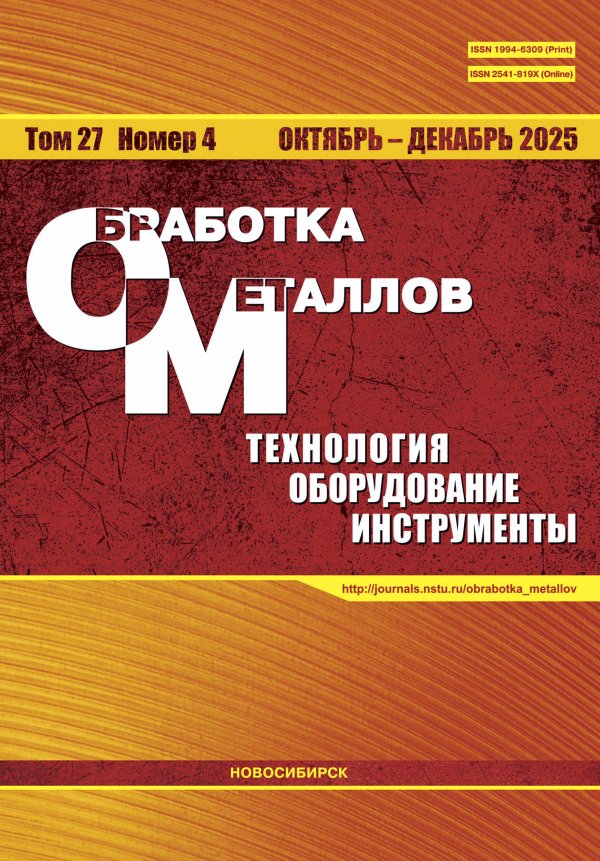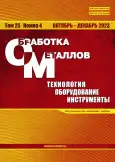Влияние геометрии наконечника сварочного инструмента на характеристики растяжения соединений сплава АА8011, полученных сваркой трением с перемешиванием
- Авторы: Раджпут Й.С.1, Шарма А.К.1, Мишра В.Н.1, Саксена К.1, Дипак Д.1, Шарма Ш.С.1
-
Учреждения:
- Выпуск: Том 25, № 4 (2023)
- Страницы: 105-116
- Раздел: ОБОРУДОВАНИЕ. ИНСТРУМЕНТЫ
- URL: https://journal-vniispk.ru/1994-6309/article/view/301464
- DOI: https://doi.org/10.17212/1994-6309-2023-25.4-105-116
- ID: 301464
Цитировать
Аннотация
Ключевые слова
Об авторах
Й. С. Раджпут
Email: yogendrasingh.rajpoot@recmainpuri.in
доцент, Инженерный колледж Раджкия, Майнпури, Уттар-Прадеш, 205119, Индия, yogendrasingh.rajpoot@recmainpuri.in
А. К. Шарма
Email: aksharma@recmainpuri.in
доцент, Инженерный колледж Раджкия, Майнпури, Уттар-Прадеш, 205119, Индия, aksharma@recmainpuri.in
В. Н. Мишра
Email: vibhooti1810@gmail.com
Инженерный колледж Раджкия, Азамгарх, Уттар-Прадеш, Индия, 276201, vibhooti1810@gmail.com
К. Саксена
Email: saxenakushal05@gmail.com
доцент, Инженерный колледж Раджкия, Майнпури, Уттар-Прадеш, 205119, Индия, saxenakushal05@gmail.com
Д. Дипак
Email: dd08iitd@gmail.com
доцент, Инженерный колледж Раджкия, Майнпури, Уттар-Прадеш, 205119, Индия, dd08iitd@gmail.com
Ш. С. Шарма
Email: shyamsunder.sharma@jaipur.manipal.edu
доктор техн. наук, доцент, Манипалский университет, Джайпур, Раджастхан, 303007, Индия, shyamsunder.sharma@jaipur.manipal.edu
Список литературы
- Friction stir butt welding: International patent application No. 9125978.8, PCT/GB92/02203 and GB patent application: 1991 / W.M. Thomas, E.D. Nicholas, J.C. Needham, M.G. Murch, P. Templesmith, C.J. Dawes.
- Dawes C., Thomas W. Friction stir joining of aluminum alloys // TWI Bulletin. – 1995. – Vol. 6. – P. 124–127.
- Effects of friction stir welding on microstructure of 7075 aluminium / C.G. Rhodes, M.W. Mahoney, W.H. Bingel, R.A. Spurling, C.C. Bampton // Scripta Materialia. – 1997. – Vol. 36 (1). – P. 69–75.
- Microstructural aspects of the friction-stir welding of 6061-T6 aluminum / G. Liu, L.E. Murr, C.S. Niou, J.C. McClure, F.R. Vega // Scripta Materialia. – 1997. – Vol. 37 (3). – P. 355–361.
- Jata K.V., Semiatin S.L. Continuous dynamic recrystallization during friction stir welding of high strength aluminum alloys // Scripta Materialia. – 2000. – Vol. 43 (8). – P. 743–749.
- Low-temperature friction-stir welding of 2024 aluminum / S. Benavides, Y. Li, L.E. Murr, D. Brown, J.C. McClure // Scripta Materialia. – 1999. – Vol. 41 (8). – P. 809–815.
- Friction-based welding processes: friction welding and friction stir welding / D.K. Rajak, D.D. Pagar, P.L. Menezes, A. Eyvazian // Journal of Adhesion Science and Technology. – 2020. – Vol. 34 (24). – P. 2613–2637. – doi: 10.1080/01694243.2020.1780716.
- On the FSW of AA2024-T4 and AA7075-T6 T-joints: an industrial case study / F. Acerra, G. Buffa, L. Fratini, G. Troiano // The International Journal of Advanced Manufacturing Technology. – 2010. – Vol. 48. – P. 1149–1157. – doi: 10.1007/s00170-009-2344-9.
- Cavaliere P., Cerri E., Squillace A. Mechanical response of 2024–7075 aluminium alloys joined by Friction Stir Welding // Journal of Materials Science. – 2005. – Vol. 40. – P. 3669–3676. – doi: 10.1007/s10853-005-0474-5.
- Rajpoot Y.S., Narayanan R.G., Das S. Predicting the effect of tool configuration during friction stir welding by cellular automata finite element analyses // International Journal of Manufacturing Research. – 2018. – Vol. 13 (4). – P. 359–381. – doi: 10.1504/IJMR.2018.095377.
- Influence of probe offset distance on interfacial microstructure and mechanical properties of friction stir butt welded joint of Ti6Al4V and A6061 dissimilar alloys / Z. Song, K. Nakata, A. Wu, J. Liao, L. Zhou // Materials & Design. – 2014. – Vol. 57. – P. 269–278. – doi: 10.1016/j.matdes.2013.12.040.
- Effect of tool eccentricity on the properties of friction stir welded AA6061 aluminum alloys / L.H. Shah, S. Guo, S. Walbridge, A. Gerlich // Manufacturing Letters. – 2018. – Vol. 15, pt. A. – P. 14–17. – doi: 10.1016/j.mfglet.2017.12.019.
- Hussain A.K., Quadri S.A.P. Evaluation of parameters of friction stir welding for aluminium AA6351 alloy // International Journal of Engineering Science and Technology. – 2010. – Vol. 2 (10). – P. 5977–5984.
- Rajpoot Y.S., Saxena K., Deepak D. A review on the influence of tool pin profile on microstructure and mechanical properties of friction stir welded joints // Advances in Manufacturing Engineering: Select Proceedings of ICFAMMT 2022. – Singapore: Springer, 2022. – P. 119–149. – doi: 10.1007/978-981-19-4208-2_10.
- Cam G., Mistikoglu S. Recent developments in friction stir welding of Al-alloys // Journal of Materials Engineering and Performance. – 2014. – Vol. 23. – P. 1936–1953. – doi: 10.1007/s11665-014-0968-x.
- Mikhail J., Ibrahim R., Lathabai S. Effect of tool design on the microstructure and microhardness of friction stir processed 5005-H34 aluminium alloy // Proceedings of SPIE. – 2013. – Vol. 8793: Fourth International Conference on Smart Materials and Nanotechnology in Engineering. – P. 334–340. – doi: 10.1117/12.2026587.
- Venkata Rao Ch., Madhusudhan Reddy G., Srinivasa Rao K. Influence of tool pin profile on microstructure and corrosion behaviour of AA2219 Al–Cu alloy friction stir weld nuggets // Defence Technology. – 2015. – Vol. 11 (3). – P. 197–208. – doi: 10.1016/j.dt.2015.04.004.
- Formability of similar and dissimilar friction stir welded AA 5182-H111 and AA 6016-T4 tailored blanks / C. Leitao, B. Emílio, B.M. Chaparro, D.M. Rodrigues // Materials & Design. – 2009. – Vol. 30 (8). – P. 3235–3242. – doi: 10.1016/j.matdes.2008.12.005.
- Weld temperature effects during friction stir welding of dissimilar aluminum alloys 6061-t6 and 7075-t6 / E.G. Cole, A. Fehrenbacher, N.A. Duffie, M.R. Zinn, F.E. Pfefferkorn, N.J. Ferrier // The International Journal of Advanced Manufacturing Technology. – 2014. – Vol. 71. – P. 643–652. – doi: 10.1007/s00170-013-5485-9.
- Sharma N., Khan Z.A., Siddiquee A.N. Friction stir welding of aluminum to copper – an overview // Transactions of Nonferrous Metals Society of China. – 2017. – Vol. 27 (10). – P. 2113–2136. – doi: 10.1016/S1003-6326(17)60238-3.
- Mechanical and metallurgical characterization of friction stir welding joints of AA6061-T6 with AA6082-T6 / P.M.G.P. Moreira, T. Santos, S.M.O. Tavares, V. Richter-Trummer, P. Vilaça, P.M.S.T. De Castro // Materials & Design. – 2009. – Vol. 30 (1). – P. 180–187. – doi: 10.1016/j.matdes.2008.04.042.
- Effect of pin length and welding speed on lap joint quality of friction stir welded dissimilar aluminum alloys / Z. Ge, S. Gao, S. Ji, D. Yan // The International Journal of Advanced Manufacturing Technology. – 2018. – Vol. 98. – P. 1461–1469. – doi: 10.1007/s00170-018-2329-7.
- Friction stir welding of lap joints: Influence of process parameters on the metallurgical and mechanical properties / G. Buffa, G. Campanile, L. Fratini, A. Prisco // Materials Science and Engineering: A. – 2009. – Vol. 519 (1–2). – P. 19–26. – doi: 10.1016/j.msea.2009.04.046.
- Davidson B.S., Neelakrishnan S. Influence of friction stir welding parameters on tensile properties of AA8011 aluminium alloy plate // Journal of Computational and Theoretical Nanoscience. – 2018. – Vol. 15 (1). – P. 93–98. – doi: 10.1166/jctn.2018.7060.
- Effect of pin profile and rotational speed on microstructure and tensile strength of dissimilar AA8011, AA01-T6 friction stir welded aluminum alloys / K. Palani, C. Elanchezhian, B. Vijaya Ramnath, G.B. Bhaskar, E. Naveen // Materials Today: Proceedings. – 2018. – Vol. 5 (11). – P. 24515–24524. – doi: 10.1016/j.matpr.2018.10.248.
- Elangovan K., Balasubramanian V. Influences of pin profile and rotational speed of the tool on the formation of friction stir processing zone in AA2219 aluminium alloy // Materials Science and Engineering: A. – 2007. – Vol. 459 (1–2). – P. 7–18. – doi: 10.1016/j.msea.2006.12.124.
- Elangovan K., Balasubramanian V. Influences of tool pin profile and welding speed on the formation of friction stir processing zone in AA2219 aluminium alloy // Journal of Materials Processing Technology. – 2008. – Vol. 200 (1–3). – P. 163–175. – doi: 10.1016/j.jmatprotec.2007.09.019.
- Elangovan K., Balasubramanian V. Influences of tool pin profile and tool shoulder diameter on the formation of friction stir processing zone in AA6061 aluminium alloy // Materials & Design. – 2008. – Vol. 29 (2). – P. 362–373. – doi: 10.1016/j.matdes.2007.01.030.
- Chandana R, Saraswathamma K. Impact of tool pin profiles in friction stir welding process – A review // Materials Today: Proceedings. – 2023. – Vol. 76, pt. 3. – P. 602–606. – doi: 10.1016/j.matpr.2022.12.097.
- Investigation on effects of variation of tool pin profile in a friction stir welding process by finite element approach for joining dissimilar materials / R. Shimpi, C.S. Kumar, R. Katarane, A.K. Shukla // Materials Today: Proceedings. – 2022. – Vol. 66, pt. 3. – P. 1361–1364. – doi: 10.1016/j.matpr.2022.05.154.
- Effect of tool tilt angle on mechanical resistance of AA6082/AA5083 friction stir welded joints for marine applications / G. Di Bella, T. Alderucci, F. Favaloro, C. Borsellino // Procedia CIRP. – 2023. – Vol. 118. – P. 879–884. – doi: 10.1016/j.procir.2023.06.151.
- Effect of tool pin shapes on microstructure and mechanical behaviour of friction stir welding of dissimilar aluminium alloys / S. Balamurugan, K. Jayakumar, B. Anbarasan, M. Rajesh // Materials Today: Proceedings. – 2023. – Vol. 72, pt. 4. – P. 2181–2185. – doi: 10.1016/j.matpr.2022.08.459.
Дополнительные файлы







